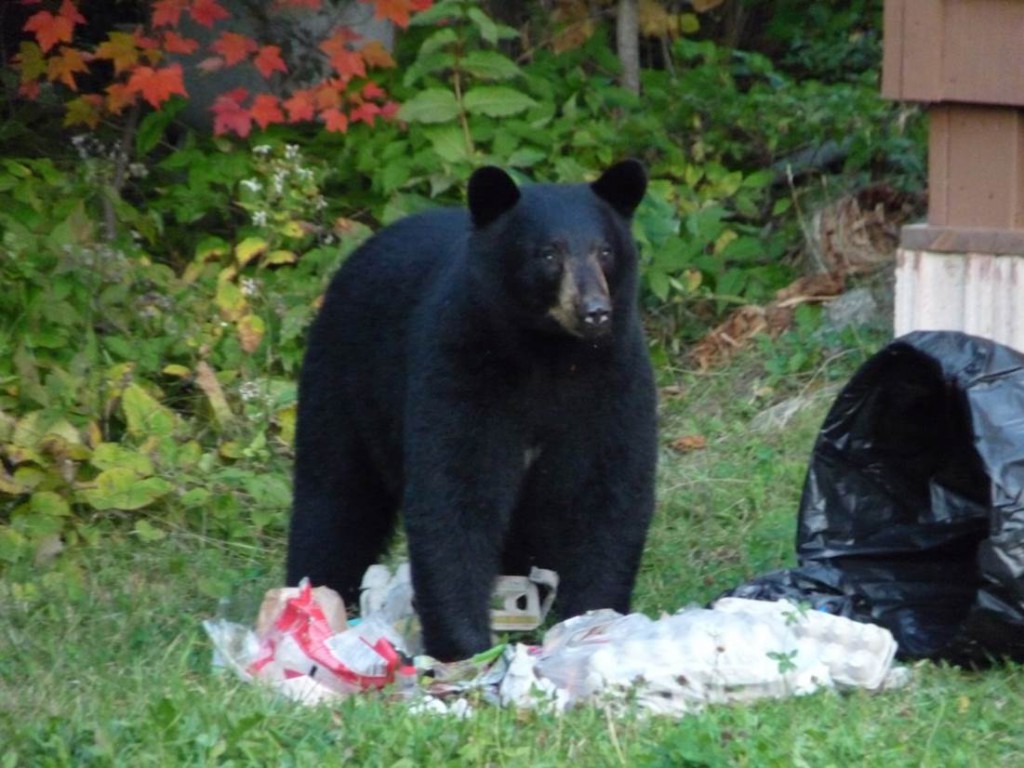Waking Up Hungry
You can probably tell by the red leaves in the background of this photo that this picture was not taken this spring. I haven’t seen any bear activity on the Gunflint Trail yet either but I’m sure we’ll see some soon. The forecast is calling for warm temperatures this week and if the bears aren’t out and about yet then I’m sure they will be by the end of the week. Here’s what the DNR says about black bears in the Spring.

DNR NEWS – FOR IMMEDIATE RELEASE March 30, 2015
Be bear-aware this spring as bears begin emerging from dens
Wildlife managers remind homeowners who live near bear habitat to be bear-aware and check their property for food sources that could attract bears this spring.
Bears usually begin emerging from their dens in late March and early April. Allowing bears to forage for food in a yard can present dangers to bears and people, according to the Minnesota Department of Natural Resources.
“While one homeowner may not be bothered by the presence of a bear in their yard, it can cause conflicts between neighbors, as well as public safety concerns, when human-related food is easy to find and the bears stop seeking their natural foods,” said Jeff Lightfoot, DNR northeast region wildlife manager. “These bears eventually get into trouble because they return again and again.”
As bears emerge from hibernation they are not immediately hungry, but over the following weeks their metabolism ramps up and they will begin looking for food at a time when berries and green vegetation can be scarce. Bears may be tempted by dog food, livestock feed, birdseed, compost or garbage.
“Bears are normally shy and usually flee when encountered,” said John Williams, DNR northwest region wildlife manager. “However, they may defend an area if they are feeding or are with their young. Never approach or try to pet a bear. Injury to people is rare, but bears are potentially dangerous because of their size, strength and speed.”
The DNR does not relocate problem bears. Relocated bears seldom remain where they are released. They may return to where they were caught or become a problem somewhere else. “In metro areas, a person who is concerned about a problem bear presenting a threat to public safety is advised to first call local law enforcement,” said Jami Markle, DNR central region assistant wildlife manager. “Leaving anything around that might be attractive to a bear could present a danger to the bear and people. When living in an area with wildlife, even the occasional bear requires some extra precautions to avoid conflict.”
The DNR offers some tips for avoiding bear conflicts.
Around the yard
Do not leave food from barbeques and picnics outdoors, especially overnight. Coolers are not bear-proof.
Replace hummingbird feeders with hanging flower baskets, which are also attractive to hummingbirds.
Eliminate birdfeeders or hang them 10 feet up and 4 feet out from the nearest trees.
Use a rope and pulley system to refill birdfeeders, and clean up seeds that spill onto the ground. Where bears are a nuisance, birdfeeders should be taken down between April 1 and Dec. 1.
Store pet food inside and feed pets inside. If pets must be fed outdoors, feed them only as much as they will eat.
Clean and store barbeque grills after each use. Store them in a secure shed or garage away from windows and doors.
Pick fruit from trees as soon as it’s ripe, and collect fallen fruit immediately.
Limit compost piles to grass, leaves and garden clippings, and turn piles regularly. Adding lime can reduce smells and help decomposition. Do not add food scraps. Kitchen scraps can be composted indoors in a worm box with minimal odor.
Harvest garden produce as it matures. Locate gardens away from forests and shrubs that bears may use for cover.
Use native plants in landscaping whenever possible. Clover and dandelions will attract bears.
For bee hives, elevate them on bear-proof platforms or erect properly designed electric fences.
Do not put out feed for wildlife (like corn, oats, pellets or molasses blocks).
Garbage
Store garbage in bear-resistant garbage cans or dumpsters. Rubber or plastic garbage cans are not bear-proof.
Keep garbage inside a secure building until the morning of pickup.
Store recyclable containers, such as pop cans, inside. The sweet smells attract bears.
Store especially smelly garbage, such as meat or fish scraps, in a freezer until it can be taken to a refuse site.
People should always be cautious around bears. If they have persistent bear problems after cleaning up the food sources, they should contact a DNR area wildlife office for assistance. For the name of the local wildlife manager, contact the DNR Information Center at 651-296-6157 or 888-646-6367, or visit www.mndnr.gov/contact/locator.html to find a local office. For more information, visit www.mndnr.gov/livingwith_wildlife/bears.

Leave a Reply
You must be logged in to post a comment.